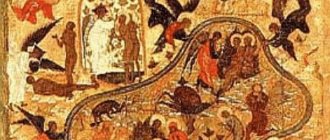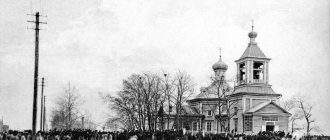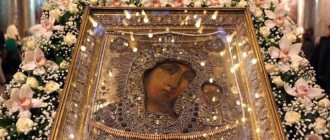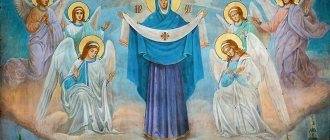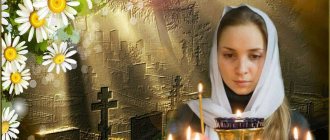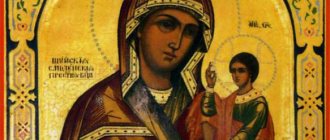There are a large number of venerated images of the Mother of God - their exact number is known only to the Lord God. There are well-known ones, but there are also special ones that patronize individual cities, for example, the Kaluga Icon of the Mother of God. She appeared mysteriously, then also disappeared unnoticed. How does the bright face of the Queen of Heaven help, what do they pray for near this unusual shrine?
About the author About the book
History of the icon
In the middle of the 18th century. The famous landowner Khitrovo lived near Kaluga. One day his maids were cleaning up the attic. One of them, named Evdokia, was distinguished by her harsh character. She could express herself rudely, although her friend made comments to her. The modest girl found a large package with a female image on it. The girl thought it was a portrait of a nun. She said that the abbess would severely punish the rude person. However, Evdokia became so angry that she spat directly on the stranger’s face.
Suddenly the girl fell as if knocked down. She remained unconscious. That night, the Mother of God visited her parents. She said that blasphemy had been committed against her icon. She ordered a prayer service to be held, to pray in front of the image and to sprinkle the culprit with holy water. After the prayer the girl woke up.
The landowner took the canvas with the image of the Virgin Mary to the estate and placed it in a frame. There turned out to be a lot of people who wanted to venerate the wonderful face. Therefore, he gave the Kaluga Icon of the Mother of God to the temple. At the same time, a copy was made and sent to the district, but the mysterious find remained in the village. Kaluzhka.
Where to hang it in the house (apartment)
The Icon of the Mother of God of Kaluga can be placed in the general iconostasis. According to church canons, it should be positioned so that the person praying faces east. According to these rules, the architecture of Orthodox churches is built; the Altar is always placed on the eastern side.
At home, it is not always possible to follow these recommendations. It happens that the eastern walls of a house (or apartment) are occupied by non-residential premises. No problem! Icons can be placed on the other side of the world. The main thing is that there is free access to them and the opportunity to concentrate on prayer. This means that everything that is not related to the iconostasis should be removed or at least covered during prayer.
Also, you need to take care of a place for church candles and safety from open fire. If the room is small, then it is better to use lamps.
In a family where joint prayer services are held, it is worth hanging the iconostasis so that it is visible to everyone and no one interferes with each other.
In a children's room, it is better to place the icon above the crib. When a child wakes up in the morning and goes to bed in the evening, he sees the image of the Mother of God and knows that she always protects him. And from childhood he learns to pray morning and evening.
Prayer to the Kaluga Icon
“O Most Holy Virgin, Mother of Christ our God, Marvelous Queen of Heaven and earth! Listen to the much-painful sighing of our hearts; Look down from Thy holy height upon us, standing with faith and love before Thy miraculous icon and praying to Thee, O Lady, with tenderness!
Do not betray the Orthodox Church to disparagement, help us, Most Holy Theotokos, to preserve the patristic Orthodox faith immaculately until the end of our days, to walk unswervingly in all the commandments of the Lord and deliver us from destructive, soul-harming teachings. We trust in Your mercy, O Wonderful Queen of Heaven and earth, Thy servants: cleanse our minds from sinful thoughts, mental relaxation, overwhelming passions, from temptations, seductions and falls; You are, O Lady, a strong refuge for repentant sinners.
Raise us from the depths of sin and water our withered hearts with true repentance, enlighten our hearts to the sight of salvation, and guide those seduced by demonic delusion onto the right path; Destroy every evil and ungodly deed; Teach and promote every good and godly deed; invest. Lady, in our hearts is the spirit of the fear of God, the spirit of piety, the spirit of meekness, humility, patience, kindness; soften our evil hearts and grant us zeal for the salvation of our neighbors.
Enlighten and teach us, O All-Merciful Intercessor, how to walk sinlessly along the path of this earthly life: for You, Most Holy One, weigh our faith and see our hope. O Lady of the world! Comfort those who mourn, help those in need; protect from lightning thunder, harmful winds, severe diseases, deadly plagues, internecine warfare, and invasions of foreign enemies.
O Most Holy Theotokos! Delivered from sudden and violent death; Grant to all of us a conversion to the true path and a Christian death of our belly that is painless, shameless, peaceful, and communicant of the Holy Mysteries. During our exodus, appear to us, O Virgin Mother of God, and deliver us from the power of demons, airy bitter ordeals and eternal fire. To those who died a sudden death, beg the mercy of Thy Son, and for all those who have died who have no relatives, begging for the repose of Thy Son, Thou Thyself be a ceaseless and warm Prayer Book and Intercessor.
Those who have ceased in faith and repentance from this temporary life, fathers, brothers, mothers and sisters, grant through Your intercession to dwell in the heavenly abodes with the Angels and with all the saints, where the voices of those who continually celebrate and joyfully glorify the Most Holy Trinity, the Father, and the Son, and the Holy Spirit , now and ever and unto ages of ages. Amen".
Icon of the Mother of God “Kaluga”
The appearance of the Kaluga Icon of the Mother of God took place in 1748 in the village of Tinkovo, not far from Kaluga, in the house of the landowner Vasily Kondratyevich Khitrovo. Two maids were sorting through old things in the attic of his house.
One of them, Evdokia, who was distinguished by her unrestrained disposition, allowed herself harsh and even obscene speech, not paying attention to the admonitions of her modest friend. Among other things, they accidentally discovered a large roll of rough canvas.
Having unfolded it, the pious girl saw the image of a Woman in a dark robe with a book in her hands. Mistaking the image for a portrait of a nun and wanting to bring Evdokia to reason, she threatened her with the wrath of the abbess.
The impudent Evdokia responded to her friend’s words with abuse and, succumbing to irritation, spat on her face. Immediately she had a seizure and fell unconscious.
A frightened friend told about what happened in the house. The next night, the Queen of Heaven appeared to Evdokia’s parents and revealed to them that it was their daughter who was blasphemously laughing at Her and ordered them to perform a prayer service in front of the desecrated icon, and to sprinkle the sick woman with the water blessed at the prayer service. After the prayer service, Evdokia recovered.
The landowner of Khitrovo took the miraculous icon into his house, where it abundantly exuded healing to those who resorted to it with faith. Subsequently, the icon was transferred with honors to the parish church in honor of the Nativity of the Blessed Virgin Mary in the village of Kaluzhka. A copy of the holy image was sent to Kaluga.
Through this icon, the Mother of God more than once showed Her protection of the Russian land in difficult times for it.
The celebration of the Kaluga Icon on September 2 was established in memory of the deliverance of Kaluga from the plague in 1771, when a monstrous epidemic literally devastated the city - the townspeople died out in entire families. The miraculous icon of the Most Holy Theotokos was then brought from the village of Kaluzhki, a religious procession walked around the entire city with it and a nationwide prayer service was served. After this, the plague in the city stopped.
The second celebration takes place on October 12, in memory of the salvation of Kaluga from the invasion of Napoleonic troops in 1812. French prisoners testified that during the battles near Kaluga and Maloyaroslavets, when they were defeated by Russian troops, they saw the Mother of God standing in the air, surrounded by luminous men.
In 1898, the celebration of the miraculous Kaluga Icon of the Blessed Virgin Mary was established on July 18 in gratitude to the Mother of God for delivering Kaluga from cholera. In those terrible days, by resolution of the City Duma, a religious procession was carried out with a miraculous image. Through the intercession of the Most Pure One, the city was saved.
The icon is also celebrated on the first Sunday of Peter's Lent.
In the difficult 30s of the 20th century for the Orthodox Church, the authorities closed the church in the village of Kaluzhki, throwing off the bells and confiscating church valuables. Traces of the miraculous image were lost. Only from fragmentary information is it possible to trace the further history of the holy icon.
There is a version that the miraculous Kaluga Icon of the Mother of God first resided in the Trinity Cathedral of the city.
Kaluga, was then placed in the local history museum, from where it was returned to the Russian Orthodox Church in the post-war years.
Currently it is located in the St. George Cathedral of Kaluga.
According to another version, the original image was replaced at a time when many copies were made of the miraculous icon, but the original was kept in the archaeological museum of the Holy Trinity Sergius Lavra, from where it was solemnly transferred to the Kaluga diocese in 1998.
However, according to documents found in the storerooms of the regional museum of local history about the transfer to the museum, among other items, of the original Kaluga Icon of the Mother of God, its description and dimensions do not correspond to the image transferred from the Lavra. In addition, the icon was in rather dilapidated condition. Thus, it is believed that the icons of the Mother of God (now there are three of them in Kaluga) are miraculous copies, and the image itself will still be revealed to the Orthodox believers of Russia.
Source: https://www.pravoslavnaya-biblioteka.ru/biblioteka/articles/ikona-bozhiej-materi-kaluzhskaya.html
Meaning and interpretation of the icon
Work as a courier at Yandex.Eda (up to 3,400 rubles per shift) leave a request →
The image is notable for the fact that it depicts the Mother of God without Christ in her arms. Researchers find the composition similar to the portrait of Queen Eudokia (1st wife of Peter I), who ended her life in a monastery. However, Evdokia Lopukhina had a stubborn disposition and led a far from monastic life, so such parallels are inappropriate.
- Saint Mary is depicted in generations. Her body is directed to the right.
- The eyes are half closed, the gaze is directed at a small book that the Virgo holds in her right hand.
- The Mother of God placed her left hand to her heart. It is obvious that the Ever-Virgin is in prayer.
In some images, the image is complemented by a crown. Clothes can be different - either modest, black or blue, or lush royal robes, richly decorated with precious stones. But what is characteristic is that the omophorion covers almost the entire figure of the Virgin Mary, only the face and palms are visible.
According to church tradition, the Mother of God spent a lot of time in prayer. She knew the Holy Scriptures well and often reflected on them. Her attention was especially attracted by the prophecy about Christ and that He would appear as the son of an earthly woman. Perhaps it is precisely the moment of such reflection that is captured here, since any icon is designed to point believers to the source of life and salvation - Christ.
- Jerusalem icon;
- What do they pray for to the Akhtyrka Icon of the Mother of God?
- About the Czestochowa Icon - .
Kaluga Icon of the Mother of God: where it is located, its meaning, what they pray for:
One of the revered shrines in the Russian Church is the Kaluga Icon of the Mother of God, which is considered the patroness of the Kaluga land. Her celebration takes place four times a year, and all thanks to the intercession of the Mother of God.
On October 12, 1812, the Kaluga land was liberated from the French, on September 2, 1771, the plague was eliminated, and on July 18, 1898, the Kaluga land was freed from cholera. Her memory is also honored during Peter's Fast on the first Sunday.
Kaluga Icon of the Mother of God: the emergence of a shrine
A very interesting story is connected with the emergence of this shrine. The icon of the Mother of God was discovered in 1748 in an attic in the village of Tinkovo, Kaluga region, in the house of the landowner Vasily Kondratyevich Khitrovo. While cleaning the attic, the maids quarreled for a long time, and then suddenly they discovered a folded canvas, on it was depicted the image of a woman in a dark robe holding a book.
One of the girls mistook this image for the image of the abbess and threatened the second maid, whose name was Evdokia, if she did not stop behaving badly and using foul language. However, she took it and spat on the canvas, saying that she was not at all afraid of her, the abbess.
And then the unexpected happened, immediately after that she was paralyzed, and the girl could not move at all. Another maid, in fright, rushed to run to her owner to tell him about what had happened.
He immediately ordered that Evdokia be taken to her parents and placed under the icons.
Vision
On the very first night, the Mother of God appeared to the parents, who told them about the careless act of their daughter, who insulted not the nun at all, but the Mother of God Herself, since it was Her image that was depicted on the canvas.
The Most Holy Virgin also informed them that, according to the will of Her Son and God, she would intercede for the city and its inhabitants. And then she told the parents to tell the priests to all pray together in front of the desecrated icon in the morning.
She ordered the relaxed woman to be sprinkled with holy water flowing from under the temple, and then the girl would be healed.
The parents fulfilled the order of the Mother of God, Evdokia was immediately healed and repented. After this, the icon was installed in the temple in the most honorable place of the landowner's house.
Miracle healings
Soon miracles began to happen. The house servant Prokhor, who had suffered from deafness for a very long time, was healed. In a dream, he saw the Most Holy One three times, who ordered him to pray with zeal in front of Her icon. Prokhor did so, and then fell asleep completely and slept for two days. When he woke up, he discovered that he had received healing.
One landowner had an only daughter who one day became seriously ill. At night, the girl saw the Most Pure One herself, who told her to pray in front of the icon, and then healing would come. The girl, waking up, told her parents everything, and then they all began to pray together, and recovery came.
After such miraculous events, the icon of the Mother of God was transferred to the Church of the Nativity of the Mother of God (Kaluzhka village).
The saving image of a nun
On the canvas, the Most Pure Mother of God deigned to appear in an appearance that was strikingly similar to the portrait of Queen Eudokia in a monastic robe and with an open book. It was written while she was in the Intercession Monastery. This happened almost four decades before the discovery of the icon of the Mother of God.
In 1771, in Kaluga itself and its environs, a pestilence cruelly carried people away to the next world.
The unfortunate people, as one, began to ask for the blessing of Archimandrite Nikodim from the Laurentian Monastery, so that he would bring the miraculous icon of the Mother of God from Kaluga. A religious procession was then held with this icon.
For three days it was carried through the streets of Kaluga, and then a national prayer service was served. And the plague receded. In memory of this, an annual celebration was established (September 2) with a religious procession around the city.
History with the French
During the war with Napoleon, the icon was transported to the city of Efremov.
In the fall, after the aggressive battles near the cities of Maloyaroslavets and Tarutin, the French troops suddenly turned to Gzhatsk, the outskirts of which they themselves had recently ravaged, and where they had nothing to profit from.
A little later, French prisoners said that they had a vision of the Virgin Mary, after which the Russians won the battles.
This was immediately reported to Alexander I, and with the blessing of the Holy Synod, he ordered the establishment of the feast of the icon of the Kaluga Mother of God on October 12 (15), which was celebrated with a city religious procession.
One day in 1868, Elder Ambrose became seriously ill in Optina Hermitage. Then the Abbot of the monastery, Isaac, sent a monk to fetch the Kaluga Icon, and this icon was immediately delivered to the monastery.
In the old man's cell, a prayer service was immediately served with an akathist to the Queen of Heaven. After these prayers, the elder began to recover.
How did the icon help?
Almost immediately, the image began to give healing to believers. Miracles were revealed not only to individuals, but to the entire city.
- In 1771, a terrible plague epidemic was recorded in the chronicles. Entire families died in Kaluga. Then the miraculous face of the Queen of Heaven was brought from the village. After the religious procession and general prayer, the disease stopped.
- In 1812, Kaluga was freed from the French invasion. As the soldiers of the enemy army themselves testified, during the battles many could observe the appearance of the Virgin Mary, surrounded by an angelic army.
In memory of these two events, church celebrations were established on September 2 and October 12. Unfortunately, the further fate of the image is a mystery. Her trace was lost in the 30s, when atheists destroyed the temple, all valuables were lost. It is believed that the Kaluga Mother of God was transferred to the Trinity Cathedral, then to the museum.
- In 1868, Elder Ambrose of Optina fell seriously ill. The monks sent one of the brothers to Kaluga - they asked to lend them the miraculous face of the Virgin. After the prayer service was completed, the illness left the monk. Since then, the image was regularly brought to Optina Pustyn.
Become a courier of the Yandex.Food service right now (up to 3,400 rubles per shift) leave a request →
Many believe that the icon that is now located in Kaluga is only a copy, and not the original, found in the Khitrovo house. After all, the description of the shrine does not coincide with the icon that is now in the cathedral. They say that the Queen of Heaven will yet reveal her face to the Orthodox believers of Russia.
How it helps and how it is venerated
After its acquisition in 1748, the icon repeatedly demonstrated its miraculous properties:
- In 1771, Kaluga and its suburbs were engulfed by a plague epidemic. Local residents turned to the Laurentian Monastery to Archimandrite Nicodemus with a request to deliver from
village of Kalushki, the miraculous icon of the Mother of God. The icon arrived in the city and a prayer service was held in front of a large number of people. Then, the clergy walked around all the streets for three days in a row and entered every house with the icon. After which the plague subsided. In honor of the miraculous deliverance, a holiday was established with a religious procession. Its date is September 2(15).
- In 1812 , when Napoleon's army was retreating, its initial route lay to Kaluga. But, for unknown reasons, it turned to Gzhatsk. Orthodox believers claim that this happened thanks to the protection of the miraculous icon. When Emperor Alexander I learned about this, he turned to the Holy Synod to establish a celebration with a religious procession of the Kaluga icon on October 12 (25).
- In 1828, Elder Ambrose (Grenkov) fell seriously ill in the Optina Desert. Hegumen Isaac sent a monk to Kalushka to bring an icon to the monastery. When the icon was delivered and a prayer service was held in the sick man’s cell, the elder recovered. This happened on August 28th.
The Orthodox Church holds a festive prayer service with a procession 4 times a year (according to the Julian calendar style):
- July 18 (31) - in memory of the deliverance from cholera (1898);
- September 2 (15) - in memory of the deliverance of Kaluga from the plague (1771);
- October 12 (25) - in memory of the liberation of Kaluga land from the French during the Patriotic War of 1812;
- First Sunday of Peter's Lent.
Procession of the Cross in our days.
During the Bolshevik revolution, the icon of the Mother of God of Kaluga disappeared without a trace. Probably, her rich robe and precious stones were barbarously plundered, and the image itself was destroyed. We managed to save only the old lists. One of them was kept in the Trinity-Sergius Lavra of the Moscow Theological Academy.
Nowadays, under the patronage of His Holiness Patriarch Alexy II, the icon was returned to the city. The list was solemnly handed over to St. George's Cathedral in Kaluga.


